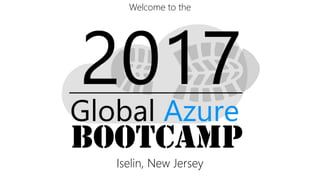Gab2017 science-lab
- 1. Welcome to the Iselin, New Jersey
- 2. Global Azure Bootcamp 2017 Science Lab
- 3. In previous years we have tried to bring you a science lab that is both interesting and represents great research. This year is no exception, this year we bring you the stars themselves! The Science Lab takes a look at Star Formation History (SFH) to see how many stars of a specific metallicity are formed in a galaxy during its lifetime. Traditional approaches are affected by uncertainties associated with observations or the limited accuracy of models when running computer code, making it difficult to accurate calculate the age of stars within a galaxy. To overcome this, we need to correct for these effects to obtain the âtrueâ SFH. The objective of the Seliga (SEcret LIfe of GAlaxies) algorithm, developed by Sebastian L. Hidalgo from the Instituto de AstrofÃsica de Canarias (IAC), is to limit the impact of all these effects so we can compare the predictions of the models more directly with the observations. This task needs a huge number of tests that can be performed successfully only by using distributed computing, like the one you will deploy in the Global Azure Bootcamp Science Lab. By taking part in the Science Lab, you will be helping to contribute to the body of knowledge in this important field that allows researchers to understand the very beginnings of the universe itself. We hope you choose to deploy the packages that will run the Seliga algorithm, and deliver real results to the researchers. The Secret Life of Galaxies
- 4. To show the power of Azure in the Global Azure Bootcamp Science Lab this year we have created a solution that maximises the use of Azure resources whilst providing the research team with large volumes of computing power. The Seliga algorithm runs in an Azure Batch process that YOU deploy and scale as you want. For extra fun, there is a dashboard showing global scores so you can compete against your friends or other people around the world. Batch Server API User Database Inputs/Outpus Event Hubs US Batch Server API User Database Inputs/Outpus Event Hubs Europe Batch Server API User Database Inputs/Outpus Event Hubs Asia BatchAzure Automation GetNewBatchJob Job 1 Job N Task 1 Task M Task 1 Task M OutputsTraffic Manager Global Dashboards Stream Analytics Global Dashboards User deployment Seliga Application Insights Azure cache Inputs DocDB Science Lab Architecture
- 5. About http://bit.ly/gablab2017about Instructions http://bit.ly/gablab2017run Lab Key: YJK-DGW-IDC Dashboard http://gablab2017.azurewebsites.net Global Azure Bootcamp 2017 Science Lab
- 6. Step 3 Use Existing Resource Group Email, FullName, TeamName, CompanyName: fill with your personal info. on the global dashboards (e-mail will Team Name = âNJ-AZUREâ Country Code = âUSâ Lab Key Code = âYJK-DGW-IDCâ






